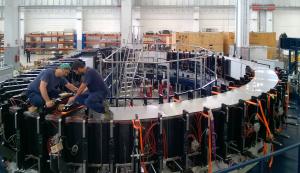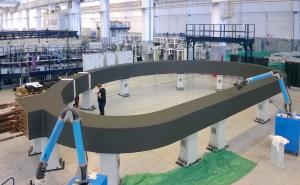First D-shaped winding pack: last activities before transfer
European contractors have completed the fabrication of the first ITER toroidal field winding pack. A series of mechanical and electrical tests now remain before the 110-tonne component is transferred to another facility for cold testing and final insertion into a stainless steel case.
In ITER 18 toroidal field magnets—each made up of a winding pack and stainless steel coil case—will surround the vacuum vessel to confine the particles of the ITER plasma in a magnetic field. Europe has the procurement responsibility for half the winding packs plus one spare; Japan is producing the other nine winding packs as well as all stainless steel coil cases.
To prepare for the impregnation step, the ASG consortium built a mould directly around the component. After implementation of fiberglass ground insulation, stainless plates—lined on the inside with a debonding agent—were mounted around the winding pack. Approximately 100 clamps (top photo) were positioned and tightened to compress the insulation and ensure that that the final product, once impregnated, respects the specified dimensions.



